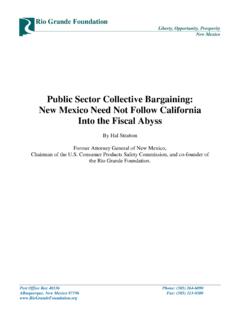Transcription of Section 4980H – Shared Responsibility for …
1 1 Section 4980H Shared Responsibility for employers Regarding health Coverage Approach to Changes in Measurement Periods or Methods Applicable to an Employee Notice 2014-49 I. PURPOSE This notice describes a proposed approach to the application of the look-back measurement method, which may be used to determine if an employee is a full-time employee for purposes of 4980H of the Internal Revenue Code (Code), in situations in which the measurement period applicable to an employee changes. This change may occur because the employee transfers within the same applicable large employer (or within the same applicable large employer member (ALE member)) from a position to which one measurement period applies to a position to which a different measurement period applies. This situation may also arise when the ALE member modifies the measurement period applicable to a position.
2 This notice is intended to address the topics for which guidance was anticipated in Section of the preamble to the final 4980H regulations (79 FR 8544, 8563 (Feb. 12, 2014)). The Treasury Department and the IRS invite comments on this proposed approach. However, taxpayers may rely on the approach proposed in this notice until further guidance is issued, and in any case through the end of the 2016 calendar year. The look-back measurement method generally involves using an employee s average hours of service per week during a period (referred to in this notice as a measurement period and in the final 4980H regulations as either an initial measurement period or a standard measurement period, depending on the circumstances) to determine if an employee is a full-time employee during a subsequent period (referred to both in this notice and the final regulations as a stability period).
3 1 The look-back measurement method is one of two alternative methods for identifying full-time employees for purposes of determining whether an ALE member is potentially subject to a payment under 4980H . Under (d)(1)(v), each ALE member that uses the look-back measurement method may establish its own measurement and stability periods, subject to rules on maximum and minimum period lengths, and may also establish different measurement and stability periods for different specified categories of employees. This notice addresses application of the look-back measurement method to the following situations: (1) An employee in a position to which one measurement period applies transfers 1 Unless otherwise noted, all terms used in this notice have the same meaning as provided in the final 4980H regulations. 2 within the same applicable large employer (whether or not within the same ALE member) to a position to which a different measurement period applies (for example, an employee moves from an hourly position to which a 12-month measurement period applies to a salaried position to which a 6-month measurement period applies); and (2) An ALE member changes the measurement method applicable to employees within a permissible category (for example, an ALE member changes the measurement period for all hourly employees for the next calendar year from a 6-month to a 12-month measurement period).
4 This notice describes how to address these situations, in both the case in which the employee is in a stability period at the time of the transfer and the case in which the employee is not yet in a stability period at that time. In general, for an employee who has been employed for a full measurement period at the time of transfer (and thus has a status as either a full-time employee or non-full-time employee for the stability period associated with that measurement period), the employee retains his or her status through the end of the associated stability period. For an employee who is not in a stability period (or administrative period) at the time of transfer, the employee s status is determined using the measurement period applicable to the second position, but including hours of service in the first position in applying that measurement period. II. BACKGROUND A.
5 Section 4980H - In General The Patient Protection and Affordable Care Act (Pub. L. 111-148) was enacted on March 23, 2010. The health Care and Education Reconciliation Act of 2010 (Pub. L. 111-152) was enacted on March 30, 2010. These statutes are collectively known as the Affordable Care Act. The Affordable Care Act added Section 4980H to the Code, and that Section was amended by the Department of Defense and Full-Year Continuing Appropriations Act, 2011 (enacted April 15, 2011, Pub. L. No. 112-10). Section 4980H applies to applicable large employers (generally, employers who employed at least 50 full-time employees, including full-time equivalent employees, on business days during the preceding calendar year). Section 4980H generally provides that an applicable large employer is subject to an assessable payment if either (1) 4980H (a) applies because the employer fails to offer its full-time employees (and their dependents) the opportunity to enroll in minimum essential coverage under an eligible employer-sponsored plan and any full-time employee is certified to receive a premium tax credit or cost-sharing reduction; or (2) 4980H (b) applies because the employer offers its full-time employees (and their dependents) the opportunity to enroll in minimum essential coverage and one or more full- time employees is certified to receive a premium tax credit or cost-sharing reduction.
6 Section 4980H is generally applicable for months beginning after December 31, 2013; however, Notice 2013-45 provides transition relief under which 4980H does not apply for 2014. 3 B. Section 4980H Identification of Full-Time Employees Section 4980H (c)(4) provides that a full-time employee for any month is an employee who is employed on average at least 30 hours of service per week. The final 4980H regulations (79 FR 8544 (Feb. 12, 2014)) provide two alternative methods for determining if an employee is a full-time employee for purposes of 4980H : (1) the monthly measurement method; and (2) the look-back measurement method. Under the monthly measurement method, an employee generally is treated as a full-time employee for any calendar month in which the employee averages 30 or more hours of service per week. See (c)(1). Under the look-back measurement method, an employee generally is treated as a full-time employee for any month within a stability period if the employee averaged 30 or more hours of service per week during the applicable measurement period preceding the stability period.
7 See (d)(1). The look-back measurement method for identifying full-time employees is available only for determining potential liability under 4980H and not for determining status as an applicable large employer. An employer that uses the look-back measurement method sets the starting date and length of two separate measurement periods: (1) the standard measurement period, which is used for ongoing employees (generally, all employees who have been employed for at least one full standard measurement period); and (2) the initial measurement period, which is used for new variable hour, seasonal, or part-time Each ALE member (that is, each separate entity within a group of entities that constitutes a single applicable large employer) may establish different measurement methods or may use measurement periods that differ in duration or that start on a different date, and each ALE member is also permitted to use different measurement methods or to use measurement periods that differ in duration or that start on a different date for certain specified categories of employees.
8 These categories are (A) collectively bargained and non-collectively bargained employees, (B) each group of collectively bargained employees covered by a separate collective bargaining agreement, (C) salaried employees and hourly employees, and (D) employees whose primary places of employment are in different States. See (d)(1)(v). III. PROPOSED APPROACH This Section III proposes an approach for applying the look-back measurement method if the measurement period applicable to a particular employee changes. Section addresses situations in which an employee transfers from one position to another within the same applicable large employer (or ALE member), in cases in which the employer uses a different measurement period for each position. Section addresses 2 An initial measurement period does not apply to new employees who are full-time employees (because they are reasonably expected at time of hire to average at least 30 hours of service per week for the months after hire), and so are not variable-hour, seasonal, or part-time employees.
9 See (d)(2). 4 situations in which the employer changes the measurement period applicable to one or more categories of employees, and also addresses situations in which an employer changes the measurement method (in other words, from the look-back measurement method to the monthly measurement method or vice versa) for one or more categories of employees. Nothing in this notice is intended to prohibit or discourage employers from adopting eligibility provisions that make some employees eligible for coverage before they would be considered a full-time employee under this approach. A. Employee transferring from a position to which one measurement period applies to a position to which a different measurement period applies This Section addresses changes in measurement methods under the following circumstances: the employee, who has been employed by an ALE member in a position (referred to as the first position) for which the employer uses the look-back measurement method, transfers to another position (referred to as the second position) for the same applicable large employer (whether or not with the same ALE member) for which the employer also uses the look-back measurement method, but with a measurement period that is different from the measurement period applicable to the first position.
10 For this purpose, two measurement periods are different if they are of different durations or if they start on different dates (or both). A transfer that may result in a change of applicable measurement method includes a transfer from one ALE member to another ALE member of the same applicable large employer or a transfer from one category of employees identified in (d)(1)(v) to another. For purposes of this proposed approach, following a transfer, an employer includes hours of service earned in the first position either by (1) counting the hours of service using the counting method applied to the employee in the first position (for example, using a weekly equivalency method for non-hourly employees), or (2) recalculating the hours of service earned in the first position using the hours of service counting method applied to the employee in the second position (for example, using a monthly equivalency method for non-hourly employees), provided that the employer treats all similarly situated employees consistently.













